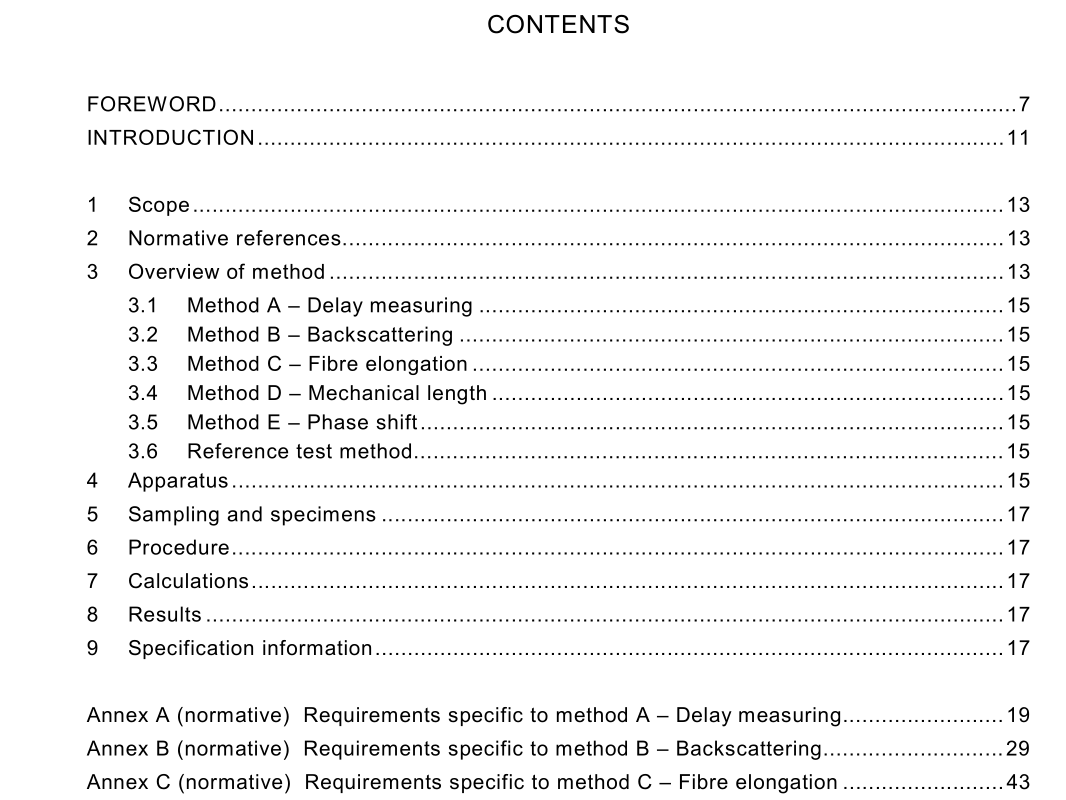IEC 60793-1-22 pdf download

IEC 60793-1-22 pdf download.Measurement methods and test procedures – Length measurement
1 Scope
This part of IEC 60793 establishes uniform requirements for measuring the length and elongation of optical fibre (typically within cable). The length of an optical fibre is one of the most fundamental values and shall be known for the evaluation of transmission characteristics such as losses and bandwidths.
2 Normative references
The following referenced documents are indispensable for the application of this document. For dated references, only the edition cited applies. For undated references, the latest edition of the referenced document (including any amendments) applies. IEC 60793-1 -40, Optical fibres – Part 1-40: Measurement methods and test procedures – Attenuation IEC 60793-1 -42, Optical fibres – Part 1-42: Measurement methods and test procedures – Chromatic dispersion IEC 60794-1 -1 , Optical fibre cables – Part 1-1: Generic specification – General
3 Overview of method
This standard gives five methods for measuring length, which are presented in the following table 1 .Information common to all measurements is contained in clauses 2 to 8. Information on specific application appears in annexes A, B, C, D, and E for methods A, B, C, D and E, respectively. 3.1 Method A – Delay measuring The delay measuring method applies to measurements of the fibre length by the measurement of the propagation time of an optical pulse or a pulse train on the basis of a known value of the group index of the fibre. Alternatively, this method is suitable for measuring the group index of a fibre of known length. Therefore, in practice this fibre length measurement method is calibrated against a known length of fibre of the same type. 3.2 Method B – Backscattering The backscattering method, which is a single-sided measurement, uses an optical time domain reflectometer (OTDR), and measures the optical power backscattered from different points in the fibre to the beginning of the fibre. 3.3 Method C – Fibre elongation This measurement method describes a procedure for determining the fibre elongation. It does not measure absolute strain, but instead measures the changes in strain from one loading condition to another. 3.4 Method D – Mechanical length This measurement method describes a procedure for determining the fibre length by winding a fibre around a fixed diameter calibrated wheel that rotates. The length is determined by the number of revolutions of the wheel.3.5 Method E – Phase shift The phase shift method describes a procedure for determining the fibre length. The length is determined from the phase shift that occurs when a predetermined modulation frequency f max is applied. 3.6 Reference test method The reference test method (RTM), which shall be the one used to settle disputes, varies depending on whether the fibre is cabled or not, such as – uncabled fibre: method D; – length of fibre within cable: method B; – elongation of fibre within cable: method C; – elongation of uncabled fibre: method C.
4 Apparatus
Annexes A, B, C, D and E include layout drawings and other equipment requirements for each of the methods A, B, C, D and E, respectively.An optical pulse generator shall preferably be a high-power laser diode, excited by an electrical pulse train generator, tunable in width. The time between two pulses shall be longer than the travelling time of the transmitted pulse (∆t, with counter) or the reflected pulse (2∆t, with backscattering equipment). Record the wavelength and the spectral width of the laser diode.The receiver shall preferably be a high-speed avalanche photodiode. The sensitivity of the optical detector shall be sufficient at the measuring wavelength, and its bandwidth shall be large enough so as not to influence the shape of the pulse.









